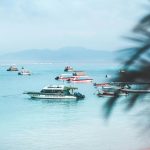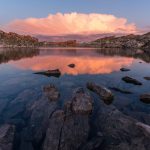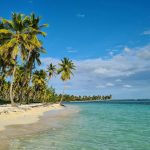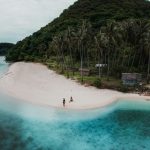Table of Contents
Last week, while sorting through my photos from 15 years of Pacific island hopping, I realized something: the most incredible places I’ve discovered aren’t in any travel magazine. These islands don’t have airports, luxury resorts, or Instagram influencers – and that’s exactly why they’re perfect.
1. Kapingamarangi Atoll, Micronesia
Imagine an island so remote that mail arrives only four times a year. That’s Kapingamarangi, a tiny atoll where I spent three unforgettable weeks after a local fishing boat captain agreed to give me a ride. The island has just 500 residents and zero hotels – but don’t let that stop you. The locals welcome visitors into their homes, and my host family refused to accept payment beyond a few fishing lures and some photographs I took of their grandchildren.
The magic happens at dawn when the entire village heads out in traditional outrigger canoes to fish in the lagoon. They still use methods passed down through generations, and they’re happy to teach you. I watched in awe as my host’s 12-year-old daughter caught more fish with a hand line in an hour than I could in a whole day with modern gear. The coral here has never been damaged by mass tourism – I counted 13 species of reef fish I’d never seen before in just one snorkeling session.
Getting there isn’t easy. You’ll need to catch a supply ship from Pohnpei, which runs monthly if weather permits. Pro tip: bring twice as much memory card space as you think you’ll need. The sunsets here, with no artificial lights for hundreds of miles, are unlike anything you’ve ever seen.
2. Tabuaeran (Fanning Island), Kiribati
Three days into my stay in Tabuaeran, I realized I hadn’t worn shoes once. This former coconut plantation turned paradise sits just north of the equator, and it’s one of the few places left where you can experience the Pacific as it was 100 years ago. The local kids still hunt octopuses on the reef using traditional methods, and they taught me how to spot them hiding in the coral (hint: look for piles of perfectly arranged shells outside their holes).
The island’s lagoon is so pristine that on calm days, you can see straight to the bottom even in the deepest parts. I spent an afternoon with local pearl divers who showed me their secret spots – including a patch of rare black-lipped oysters they’ve been carefully protecting for generations. They let me keep one of the pearls after I helped them repair their boat’s outboard motor.
You can get here by cargo ship from Christmas Island, but schedules are… flexible. Pack essential supplies, but don’t worry too much about food – the locals are incredible fishermen, and there’s always more than enough to share.
3. Niue
“The Rock of Polynesia” isn’t technically unknown, but most people who visit the South Pacific have never heard of it. Unlike its sandy cousins, Niue is a raised coral atoll with dramatic limestone cliffs and underwater caves that will make you feel like you’ve discovered another planet. I found a hidden cove where spinner dolphins come to rest during the day – the locals know about it, but it’s not in any guidebook.
During whale season (July to October), humpbacks swim so close to shore that you can hear their songs while having breakfast in the coastal villages. But here’s the real secret: there’s a network of underwater caves that amplify the whale songs. Local guide Tali (ask for him at Niue Dive) showed me one where you can float in complete darkness and feel like you’re in the middle of a whale concert.
The island’s population drops to about 1,600 during the off-season, and you’ll often find yourself alone on beaches that would be packed anywhere else. Just don’t expect sandy stretches – the coastline is mostly dramatic limestone formations with natural swimming pools carved by centuries of waves.
4. Rennell Island, Solomon Islands
Ever wondered what the edge of the world looks like? That’s Rennell Island. The southern end of the island hosts Lake Tegano, the largest lake in the insular Pacific and a UNESCO World Heritage site. But what the UNESCO description doesn’t tell you is that there’s a family on the eastern shore that makes the best fresh coconut crab curry you’ll ever taste. Their recipe has been passed down for five generations, and yes, they’ll teach you if you ask nicely.
The lake is home to several species found nowhere else on Earth, including a sea snake that evolved to live in freshwater. I spent a week with local guides who showed me hidden caves with ancient Polynesian petroglyphs that even archaeologists haven’t documented yet. At night, the bioluminescent organisms in the lake create light shows that make the Aurora Borealis look tame.
Getting here requires a combination of small planes, boats, and a lot of patience. The airstrip is a cleared patch of coral, and flights only land when weather permits. Pack light but bring good hiking boots – the island’s interior is a maze of limestone formations and hidden valleys.
5. Hatohobei (Tobi), Palau
If you think Palau’s Rock Islands are remote, wait until you visit Hatohobei. This tiny island is home to just 30 people, and they’ve managed to preserve their traditional way of life while selectively adopting modern conveniences. The chief’s grandson, John, runs the island’s only solar-powered internet connection, which he uses to sell hand-carved model canoes online – each one takes three months to make.
The real treasure here lies underwater. The reefs around Hatohobei have never been fished commercially, and the results are mind-blowing. I saw schools of bump-head parrotfish so large they looked like underwater buffalo herds. The locals showed me a spot they call “shark kindergarten” where reef shark pups gather in shallow water to practice hunting – something I’d never seen in 20 years of diving.
You’ll need special permission to visit, and getting there involves convincing a supply boat captain to make an extra stop. Bring gifts for the community (solar-powered lights and fishing gear are always welcome) and be prepared to participate in island life – everyone here has a role to play.
A Different Kind of Paradise
Yesterday, someone asked me if these islands are “worth the trouble” of getting to. I showed them a photo of my last night on Kapingamarangi – stars reflected in the lagoon, bioluminescent plankton lighting up the waves, and not another artificial light in sight. Some places are worth not just the trouble, but every ounce of effort it takes to reach them.

I’m Garrett, a seasoned photojournalist with a passion for uncovering the world’s hidden treasures. My journey is fueled by a deep curiosity for diverse cultures and breathtaking landscapes. When I’m not behind the lens capturing the world’s wonders, you can find me exploring underwater realms or sharing my passion for discovery with my two adventurous children.




